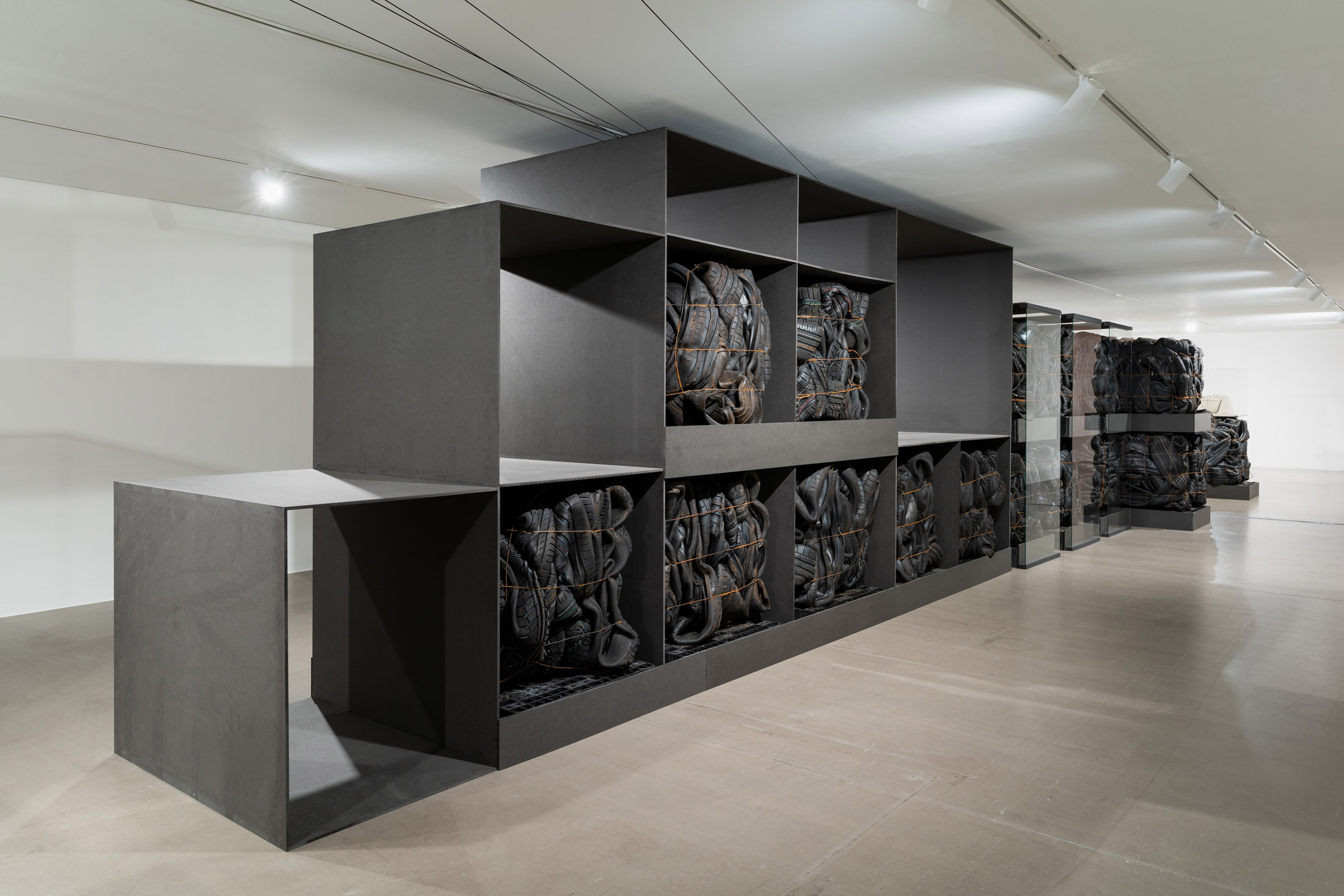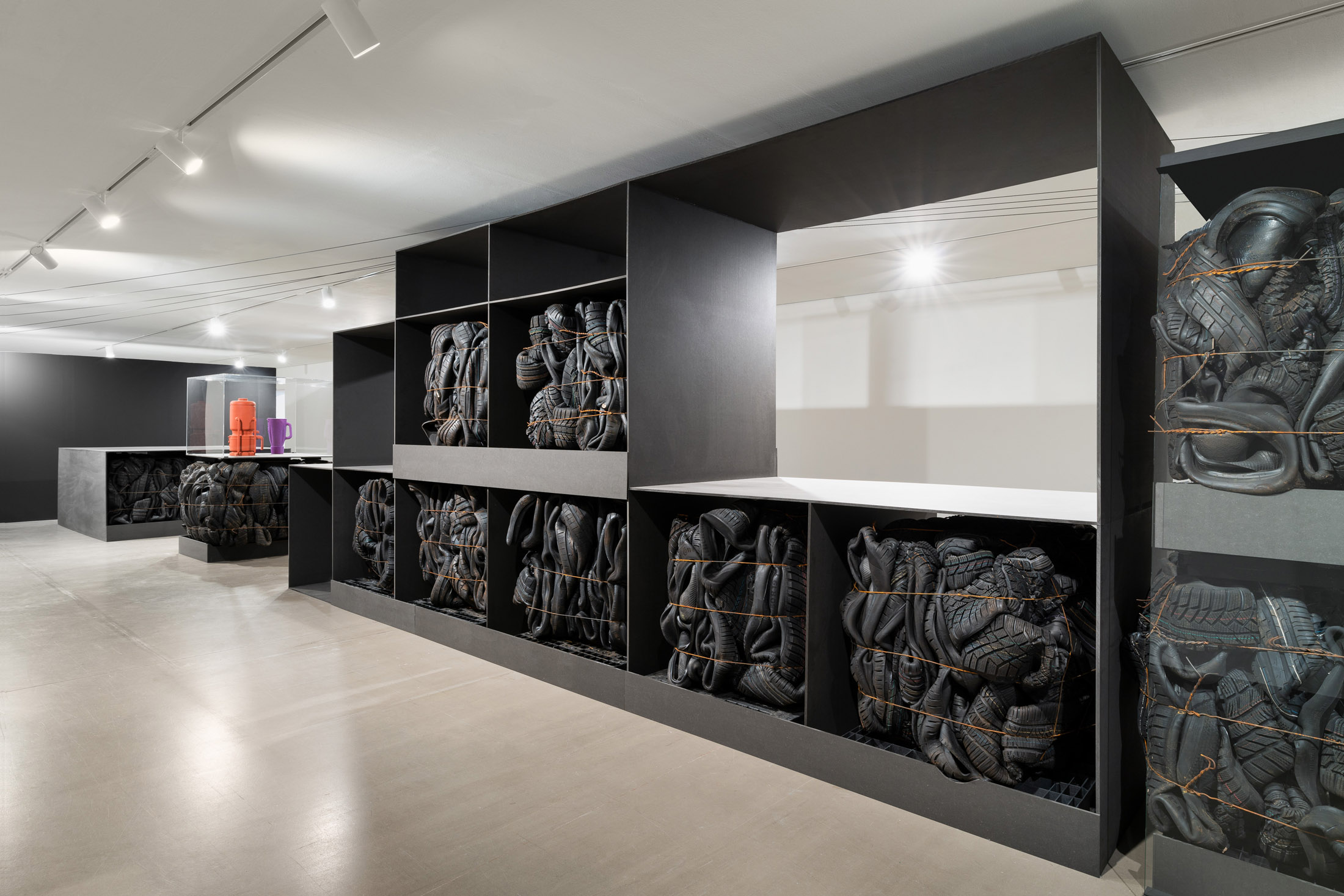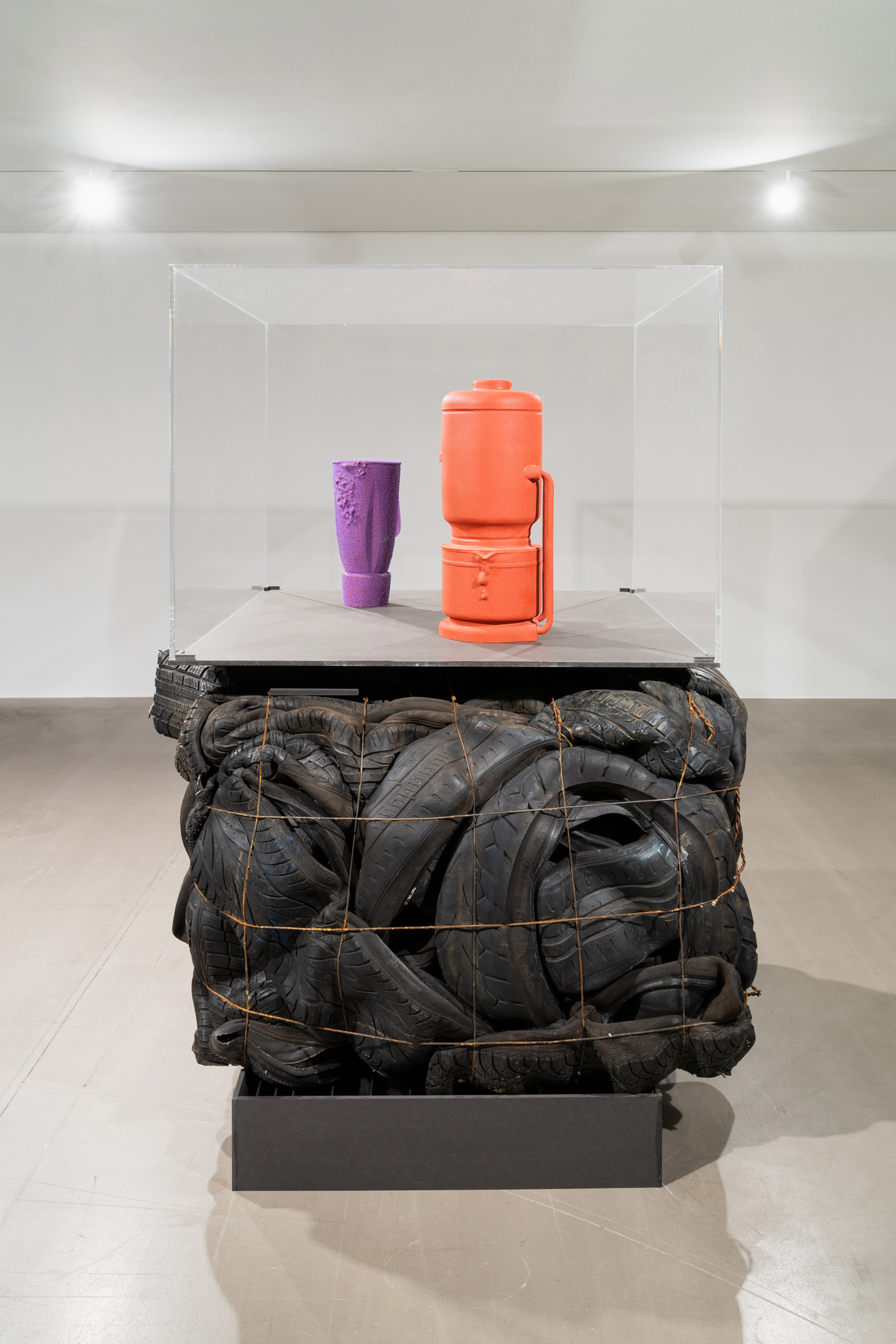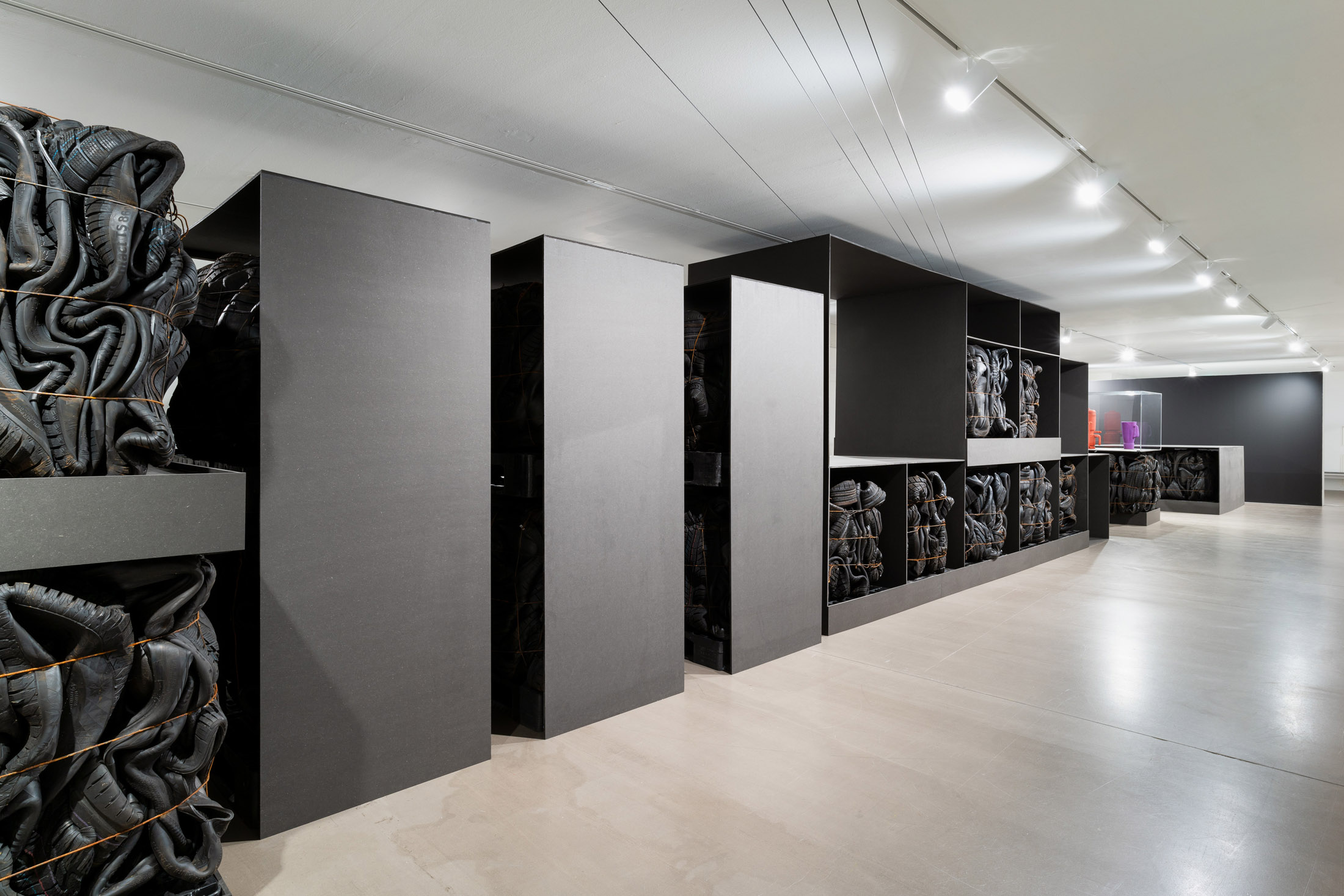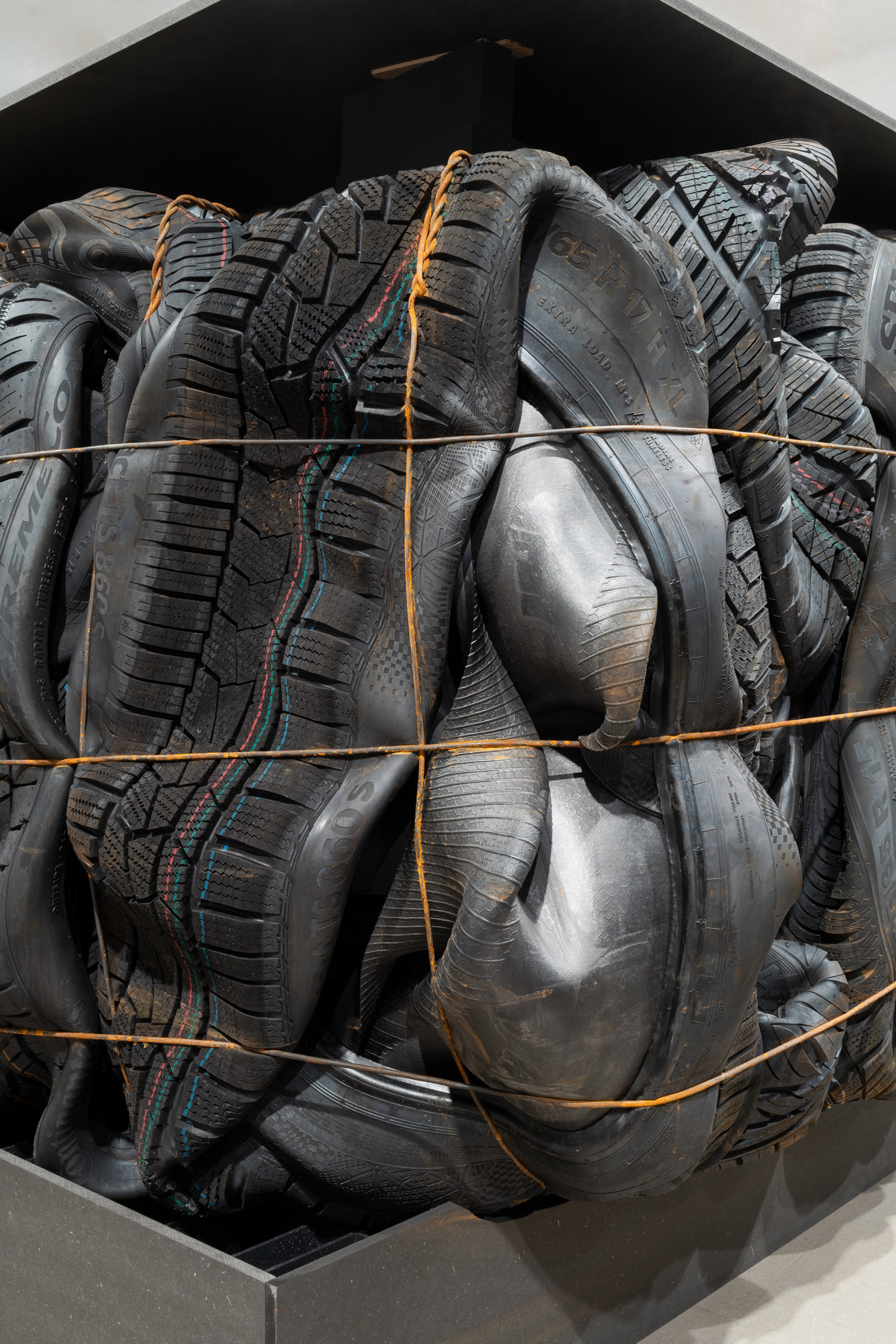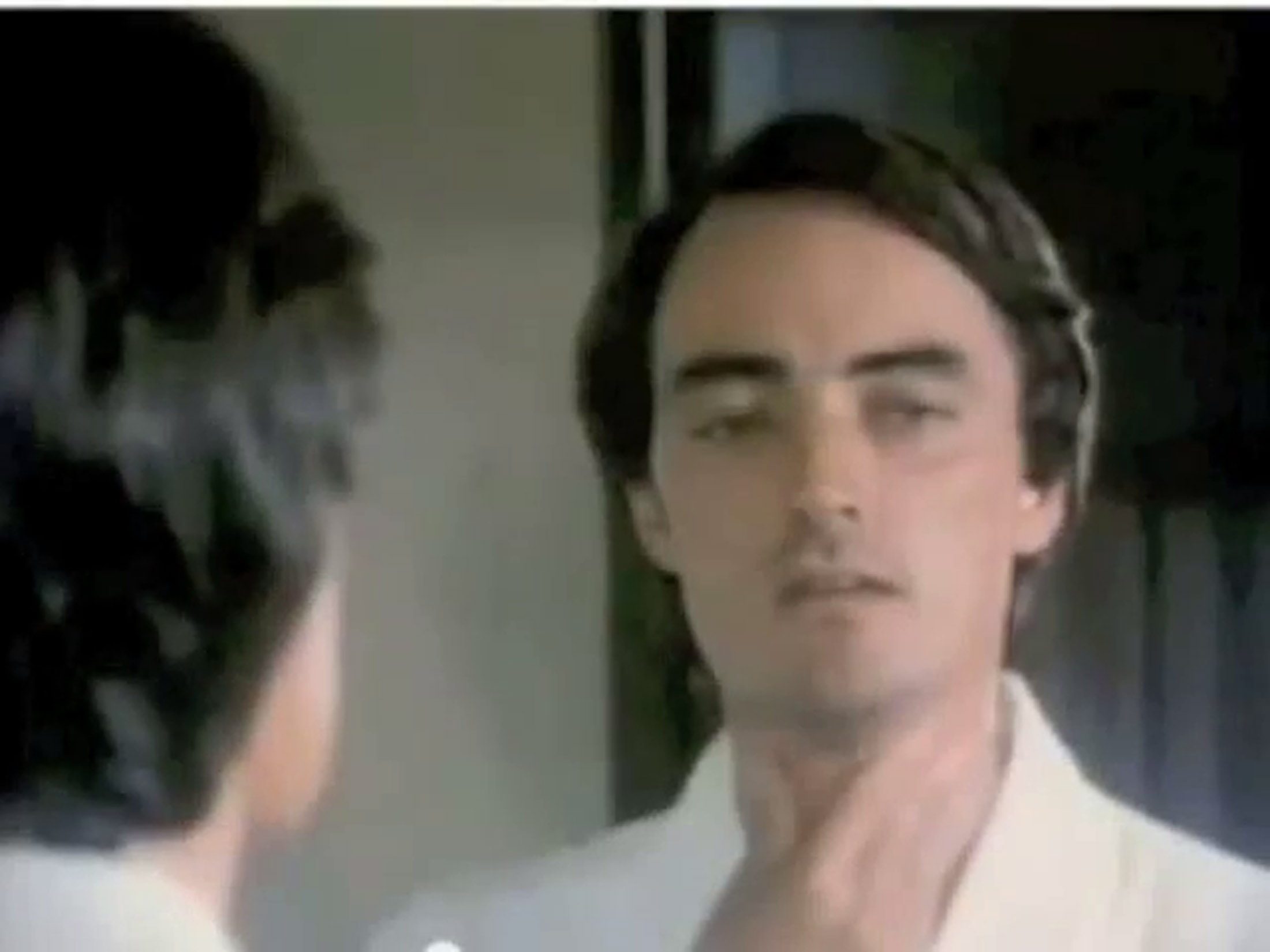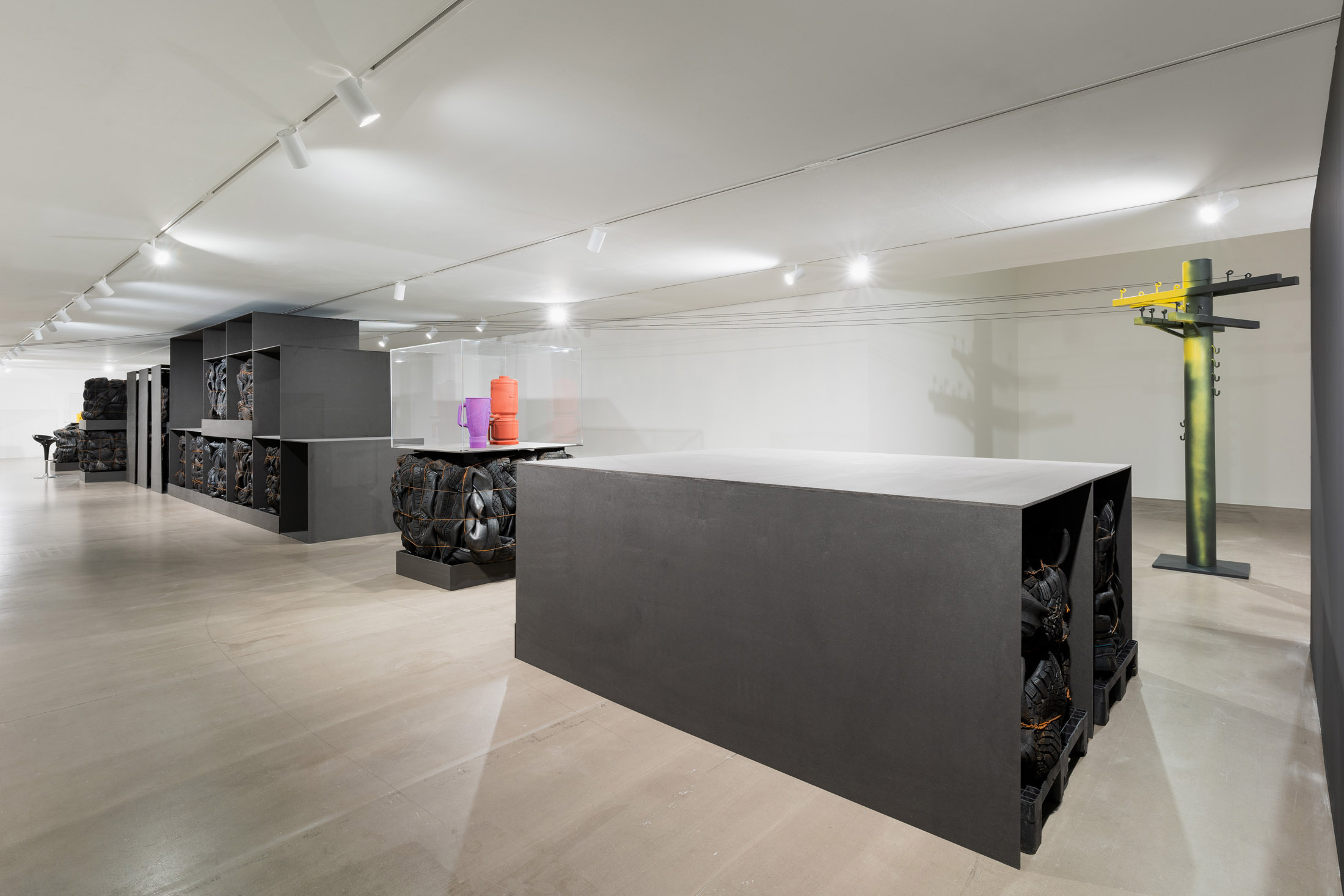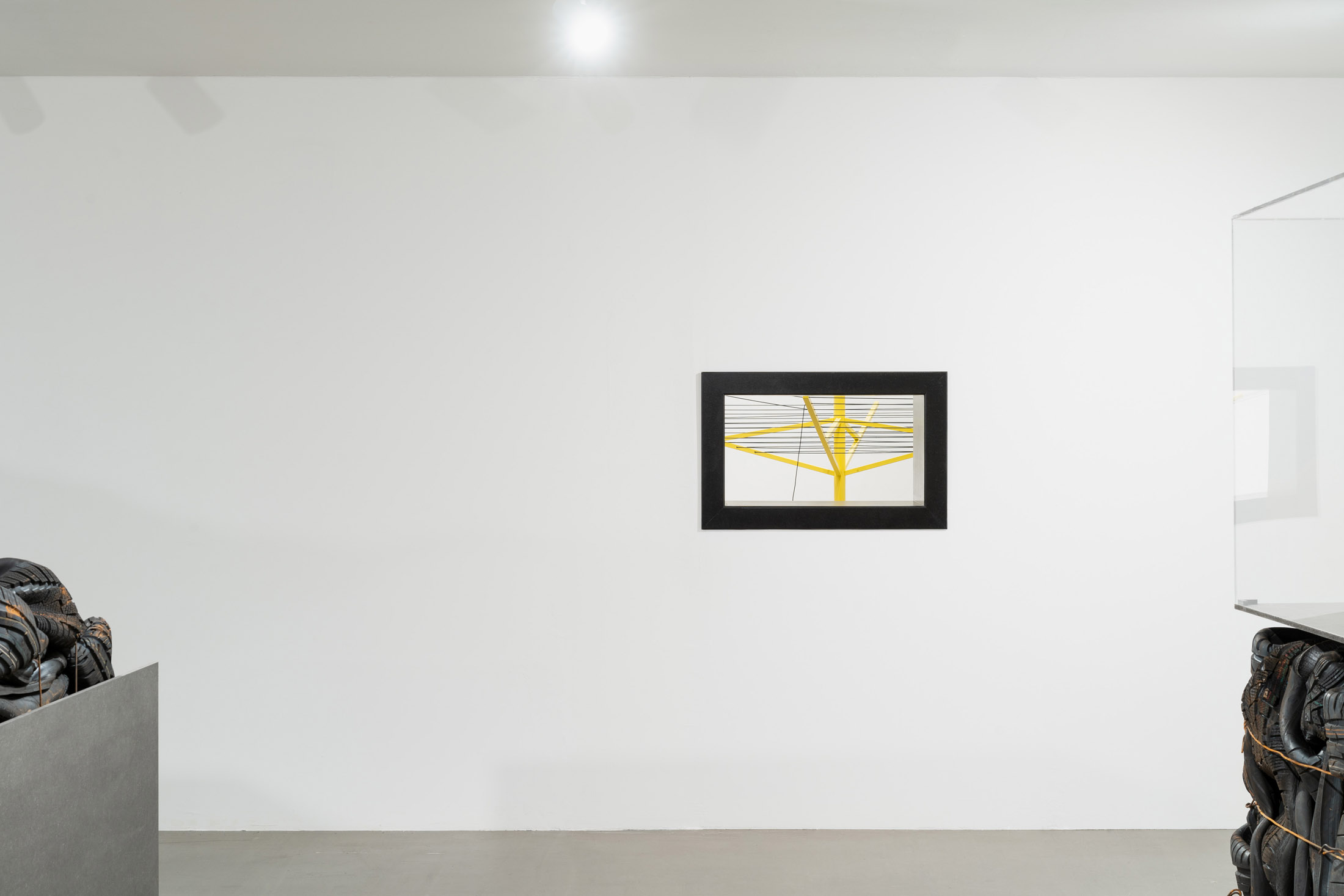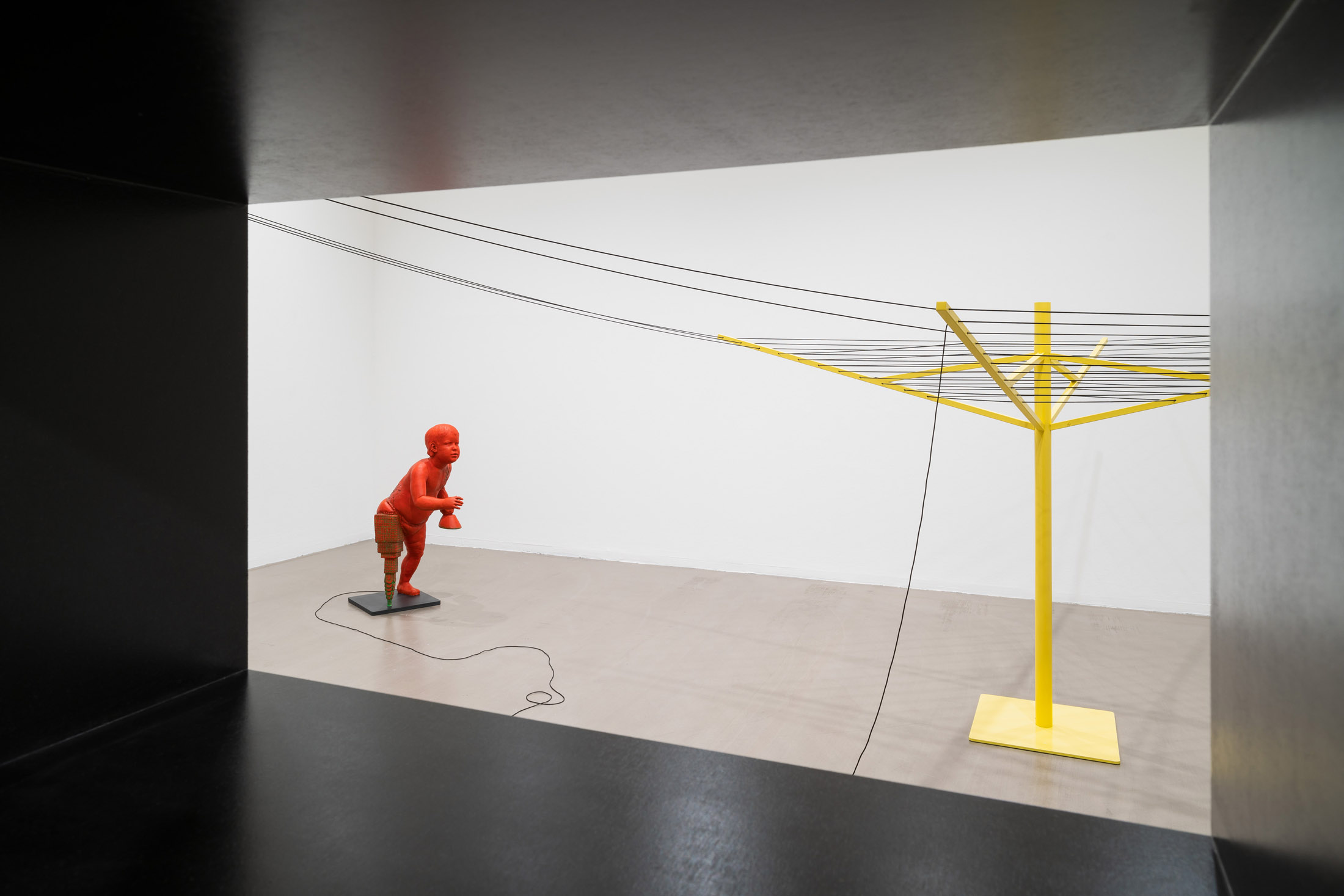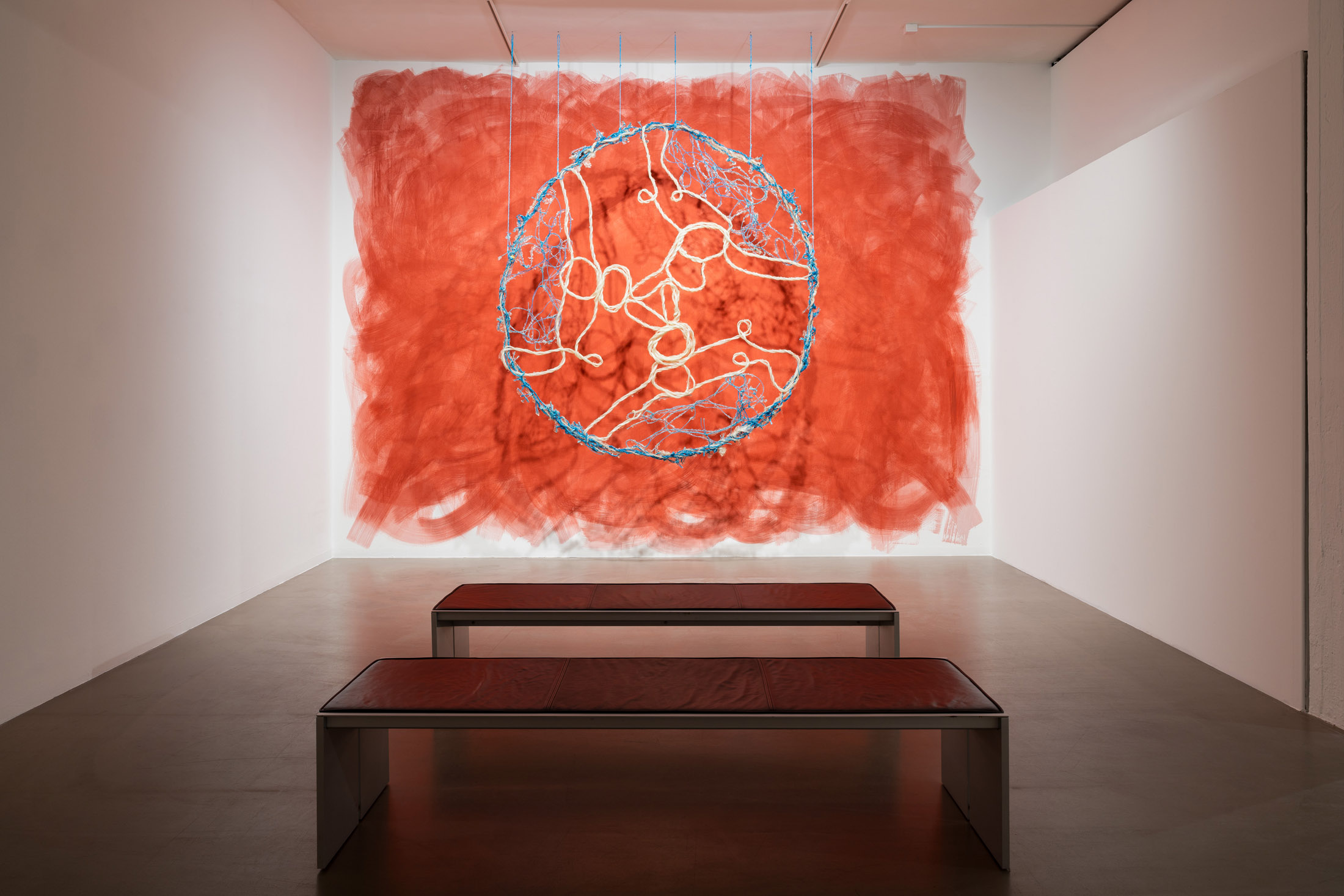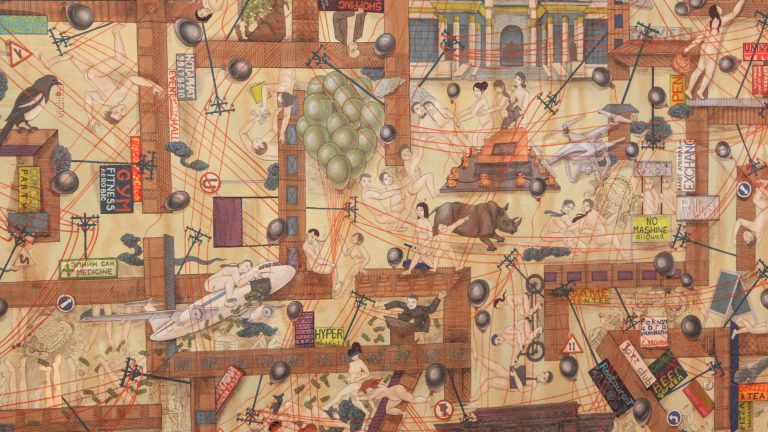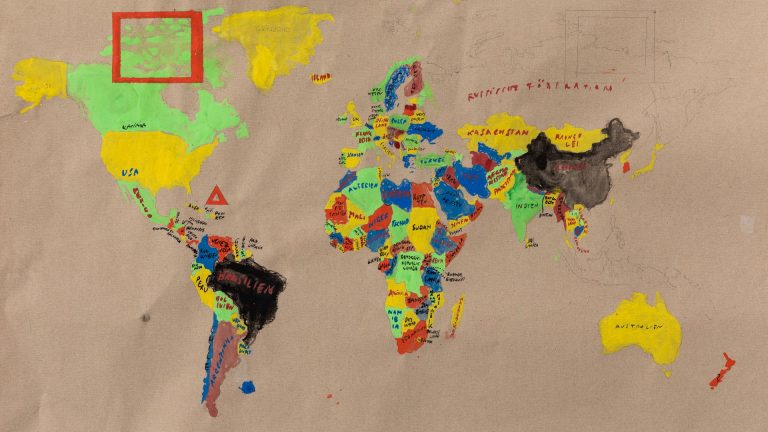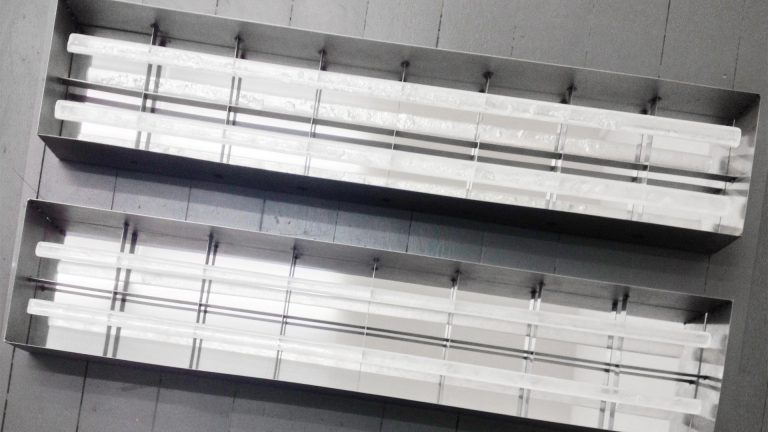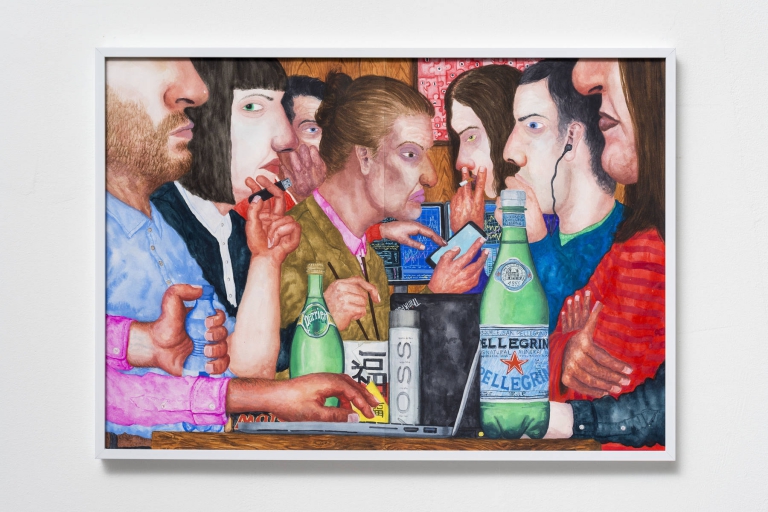Artist: Lena Henke
Exhibition title: Good Year
Venue: Marta Herford Museum, Herford, Germany
Date: October 19 – December 2, 2023
Photography: all images copyright and courtesy of the artist and Marta Herford Museum
In an installation created specifically for the Lippold Gallery, Lena Henke, who grew up in Westphalia and now lives in New York and Berlin, opens up a space that mediates between feelings of homeland, childhood memories, and society’s ideals of a nuclear family and consumer goods. Olfactory impressions play a distinct role, as do sculptural questions of the pedestal, and the presentation and staging of works of art. Lena Henke is the fifth artist to be honored with the Marta Award by the Wemhöner Foundation. In addition to prize money available for, among other things, the production of a new work for the Marta Collection, an exhibition has been associated with this award since 2020 and will continue to be so in the future. The solo exhibition will be accompanied by a publication to be launched at Marta Herford in the presence of the artist on Sunday, November 12, 2023.
In connection with the Marta Award, Lena Henke has developed a scent for the Marta Collection that will set the mood for the exhibition as soon as one enters the gallery: the work titled “Marta L. Henke” (2023) . The fragrance functions as a sculpture which spreads out into the room, evoking in turn the invisible spaces of the imagination. The idea for this scent originated in memories of the smells that can be found among the buildings, streets, and fields of Westphalia.
In addition to this regional connection, another of Herford’s characteristics offers a point of contact: In recent years, Henke has worked intensely with the kitchen, a space which is extremely relevant to eastern Westphalia. The artist has grappled in particular with the social significance of the kitchen and its furnishings. Her research initially focused on the Hansaviertel in Berlin: A West German architectural project of the 1950s and a utopia of democratic ideas for housing. Internationally renowned architects found fulfillment in their buildings, but Henke was above all interested in the roles that women played in developing the neighborhood and its apartment buildings. “How might the futures of design affect the labor of our desires? The task of reimagining the embodied experience of space animates Lena Henke’s artistic practice.” [Carlos Kong, “Romancing the Kitchen in the City of Tomorrow,” in Lena Henke: I Don’t Love Berlin, Crazy City!, Cologne, 2022, p. 78.]
The sculptural result of this research is an edition of four versions of iconic kitchen appliances, all designed by Braun, with which the apartments of the Hansa Quarter were equipped. Digitally altered, enlarged one and a half times, cast and covered in rubber granules carrying monochrome colors typical of the 1950s. “Better Be Old Iron Than New Tin (Mixer)”, “The Mind Is Like An Umbrella It’s Most Useful When Open (Saftpresse)”, “Every One Of My Buildings Begins With An Italian Journey (Kaffee)” and “Form Follows Feminine (Kueche)” (2022) represent symbols of their era. The titles of the works are quotations from star architects of the time: Egon Eiermann, Alvar Aalto, Walter Gropius, and Oscar Niemeyer. At Marta, these works reappear in the newly produced, spatial installation “P7340LH” (2023) .
The black formation of car tires and wooden elements that dominates the main space consists of around 2,000 car tires pressed into cubes, each segment of which measures 120 by 100 by 80 centimeters and weighs 600 kilograms. In their layout, the artist makes reference to the P7340: a kitchen “designed for men,” by the company Poggenpohl in Herford in cooperation with Porsche Design. It was intended to speak to a “new” clientele with its carbon and aluminum, a smooth, pure aesthetic, and a dark color scheme. The domestic environment meets the ultimate promise of freedom of the street: the kitchen and the car are combined in the design but also in the impressive installation. In addition, while alluding to John Chamberlain’s sculptures made of crushed and compressed cars, Henke employs the malleability of rubber from tires that are no longer usable and combines it with the reduced form of the cube in a gesture that recalls Minimal Art. This interplay of kitchen furnishings, sculpture, and display becomes an ambiguous object in the museum space.
Here, issues of sculpture as power symbolism but also references to the masculine and the feminine are physically juxtaposed. Anti-sensual, pure material is recomposed and supplemented by other works of art: On top of one of the many cubes, reminiscent of a large kitchen table, the promotional film “The Critic Laughs“ (1980) by Richard Hamilton plays in an endless loop. It explores the language of design while also making reference to designs by Braun.
Black cables run through the room along the ceiling. Going beyond the kitchen, they are part of a group of sculptures titled “The Baby Will Always Be Me“ (2020) . The assembly forms a diagonal line in the gallery, consisting of the figure of a cyborg-like child, an oversized rotary clothesline, and a downscaled utility pole. The square outdoor laundry rack called a ‘Hills Hoist’ was first produced in Australia a hundred years ago and was an attempt to modernize domestic labor. Power lines extend from the utility pole and connect the three elements. Determined to create a work of brutal realism, Henke turned her child-ego into a sculpture. But one leg has been replaced by the tip of the Chrysler Building in New York and one hand by a horse’s hoof.
In the final room, the sculpture “Dreihasenbild“ (Three Hare Picture) (2015), is a metaphor for fertility as well as for the hare’s speed. It is a variation on the iconic late Gothic window in the cloister of Paderborn Cathedral. Here the three hares forming a circle are made of wrapped fiberglass rope and straw straps that have been “frozen” in synthetic resin. The circular arrangement causes the ears of the hares to overlap, so that only three ears are visible, even though each hare appears to have two. This motif, known as a triskelion, is significant in different ways in many cultures worldwide. The most widespread meanings are the triads of birth–life–death and of past–present–future.
Lena Henke’s work is marked by a questioning of her sociocultural surroundings. She studies power structures and hierarchies, developing many of her installations in situ and relates to the existing qualities of a space as well as to its interpretation and formation. Her work is also characterized by a strong awareness of art history and sculptural traditions. She often deliberately borrows from existing works and transforms them into her own forms. At the same time, she creates her own iconographic pictorial systems within her oeuvre in that certain motifs recur again and again and are continuously further refined. Not least is Henke testing the conditions and possibilities of sculpture using different methods of production. In the process she creates engaging sculptures that open onto a complex system of reference.
Lena Henke was born in Warburg in 1982; she lives and works in Berlin and New York. From 2004 to 2010, she studied at the Städelschule in Frankfurt am Main and the Glasgow School of Art (Scotland), receiving her degree in Frankfurt with Prof. Michael Krebber. The artist was awarded the Rubens-Förderpreis of the City of Siegen in 2019, and that same year she received a Pollock-Krasner Foundation Grant.
Henke has presented solo exhibitions at, among other places, Museum für Gegenwartskunst Siegen, DE (“My Fetish Years”, 2019), Kunsthalle Zürich, CH (“An Idea of Late German Sculpture: To the People of New York”, 2018), Schirn Kunsthalle, Frankfurt am Main, DE (“Schrei mich nicht an, Krieger!”, 2017), S.A.L.T.S. in Basel, CH (“My History of Flow”, 2016), Kunstverein Braunschweig, DE (“Double Concave”, 2016), Dortmunder Kunstverein, DE (“Hellweg”, 2015) and Skulpturenmuseum Glaskasten in Marl, DE (“Yes, I’m pregnant”, 2014).
She has participated in numerous group exhibitions internationally, including Frieze Sculpture at the Rockefeller Center, New York, USA (2020); Kunsthalle Bielefeld, DE (2019); Skulpturengarten Tillburg, NL (2019);Whitney Museum of Art, New York, USA (2018); CCS Hessel Museum of Art, Annandale-on-Hudson, NY, USA (2018); Kunstmuseum Luzern, CH (2018); Schirn Kunsthalle, Frankfurt am Main, DE (2017); Made in Germany III, a production of the Sprengel Museum Hannover with the Kestnergesellschaft and the Kunstverein Hannover, DE (2017); Museum of Contemporary Art, Detroit, MI, USA (2017); Timisoara Contemporary Art Biennale, RO (2017); Manifesta 11, Zurich, CH (2016); 9. Berlin Biennale, DE (2016); La Biennale de Montréal, CA (2016); Kunstverein Braunschweig, DE (2016); Triennale of Small Sculpture, Fellbach, DE (2016); S.A.L.T.S., Basel, CH (2016); The New Museum, New York, USA (2015); Socrates Sculpture Park, New York, USA (2015); Kunsthalle Bern, CH (2014); Künstlerhaus Graz, AT (2014); Institute of Contemporary Art, Miami, FL, USA (2013); Kunstverein Aachen, DE (2012). In the winter of 2023 she will present a new outdoor installation on the rooftop of the Aspen Art Museum in Colorado.
The artist’s works are found in the collections of museums such as the Whitney Museum in New York; the CCS Hessel Museum of Art in Annandale-on-Hudson, NY; the Bundeskunstsammlung in Bonn; the Belvedere, Vienna; the MAMCO (Musée d’art moderne et contemporain), Geneva; the Institute of Contemporary Art, Miami, FL: and the Skulpturenmuseum Glaskasten, Marl, DE. Henke’s permanent outdoor sculptures can be seen in the Skulpturen Park Köln and the Socrates Sculpture Park in New York, among other places.
Installation view of, “Lena Henke: Good Year – Marta-Preis der Wemhöner Stiftung”, ©2023 Lena Henke, Marta Herford; Foto: Gunnar Meier
Installation view of, “Lena Henke: Good Year – Marta-Preis der Wemhöner Stiftung”, ©2023 Lena Henke, Marta Herford; Foto: Gunnar Meier
Installation view of, “Lena Henke: Good Year – Marta-Preis der Wemhöner Stiftung”, ©2023 Lena Henke, Marta Herford; Foto: Gunnar Meier
Installation view of, “Lena Henke: Good Year – Marta-Preis der Wemhöner Stiftung”, ©2023 Lena Henke, Marta Herford; Foto: Gunnar Meier
Installation view of, “Lena Henke: Good Year – Marta-Preis der Wemhöner Stiftung”, ©2023 Lena Henke, Marta Herford; Foto: Gunnar Meier
Installation view of, “Lena Henke: Good Year – Marta-Preis der Wemhöner Stiftung”, ©2023 Lena Henke, Marta Herford; Foto: Gunnar Meier
Installation view of, “Lena Henke: Good Year – Marta-Preis der Wemhöner Stiftung”, ©2023 Lena Henke, Marta Herford; Foto: Gunnar Meier
Installation view of, “Lena Henke: Good Year – Marta-Preis der Wemhöner Stiftung”, ©2023 Lena Henke, Marta Herford; Foto: Gunnar Meier
Installation view of, “Lena Henke: Good Year – Marta-Preis der Wemhöner Stiftung”, ©2023 Lena Henke, Marta Herford; Foto: Gunnar Meier
Installation view of, “Lena Henke: Good Year – Marta-Preis der Wemhöner Stiftung”, ©2023 Lena Henke, Marta Herford; Foto: Gunnar Meier
Installation view of, “Lena Henke: Good Year – Marta-Preis der Wemhöner Stiftung”, ©2023 Lena Henke, Marta Herford; Foto: Gunnar Meier
Installation view of, “Lena Henke: Good Year – Marta-Preis der Wemhöner Stiftung”, ©2023 Lena Henke, Marta Herford; Foto: Gunnar Meier
Installation view of, “Lena Henke: Good Year – Marta-Preis der Wemhöner Stiftung”, ©2023 Lena Henke, Marta Herford; Foto: Gunnar Meier
Installation view of, “Lena Henke: Good Year – Marta-Preis der Wemhöner Stiftung”, ©2023 Lena Henke, Marta Herford; Foto: Gunnar Meier
Installation view of, “Lena Henke: Good Year – Marta-Preis der Wemhöner Stiftung”, ©2023 Lena Henke, Marta Herford; Foto: Gunnar Meier
Installation view of, “Lena Henke: Good Year – Marta-Preis der Wemhöner Stiftung”, ©2023 Lena Henke, Marta Herford; Foto: Gunnar Meier
Installation view of, “Lena Henke: Good Year – Marta-Preis der Wemhöner Stiftung”, ©2023 Lena Henke, Marta Herford; Foto: Gunnar Meier
Installation view of, “Lena Henke: Good Year – Marta-Preis der Wemhöner Stiftung”, ©2023 Lena Henke, Marta Herford; Foto: Gunnar Meier
Installation view of, “Lena Henke: Good Year – Marta-Preis der Wemhöner Stiftung”, ©2023 Lena Henke, Marta Herford; Foto: Gunnar Meier
Installation view of, “Lena Henke: Good Year – Marta-Preis der Wemhöner Stiftung”, ©2023 Lena Henke, Marta Herford; Foto: Gunnar Meier
Installation view of, “Lena Henke: Good Year – Marta-Preis der Wemhöner Stiftung”, ©2023 Lena Henke, Marta Herford; Foto: Gunnar Meier
Installation view of, “Lena Henke: Good Year – Marta-Preis der Wemhöner Stiftung”, ©2023 Lena Henke, Marta Herford; Foto: Gunnar Meier
Installation view of, “Lena Henke: Good Year – Marta-Preis der Wemhöner Stiftung”, ©2023 Lena Henke, Marta Herford; Foto: Gunnar Meier
Installation view of, “Lena Henke: Good Year – Marta-Preis der Wemhöner Stiftung”, ©2023 Lena Henke, Marta Herford; Foto: Gunnar Meier
Installation view of, “Lena Henke: Good Year – Marta-Preis der Wemhöner Stiftung”, ©2023 Lena Henke, Marta Herford; Foto: Gunnar Meier



